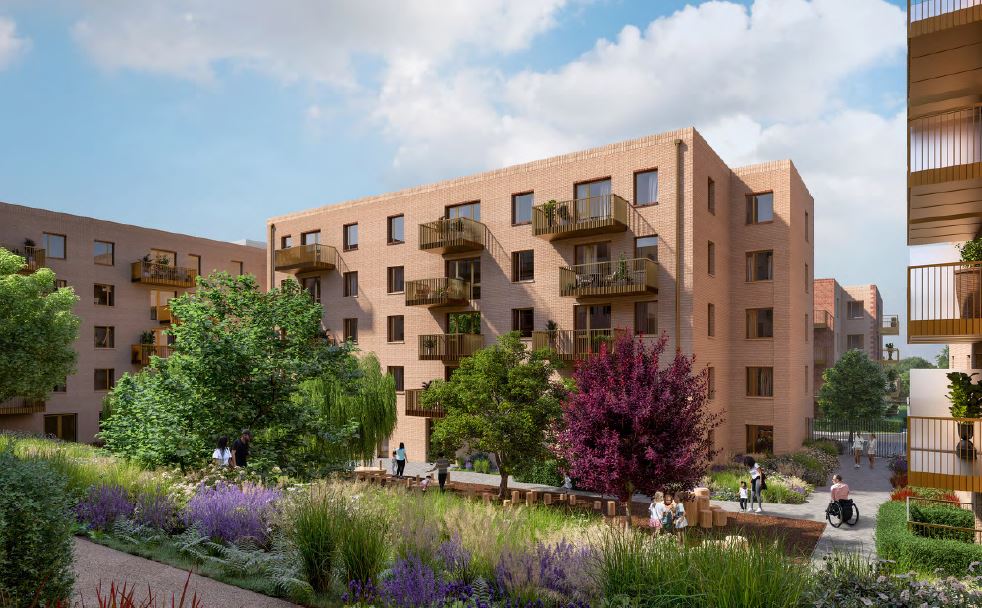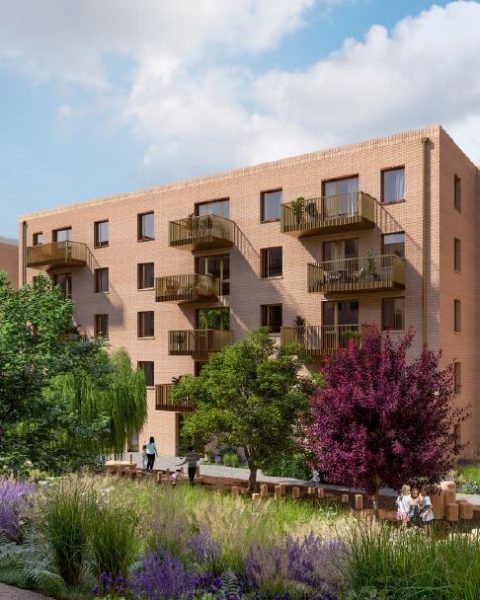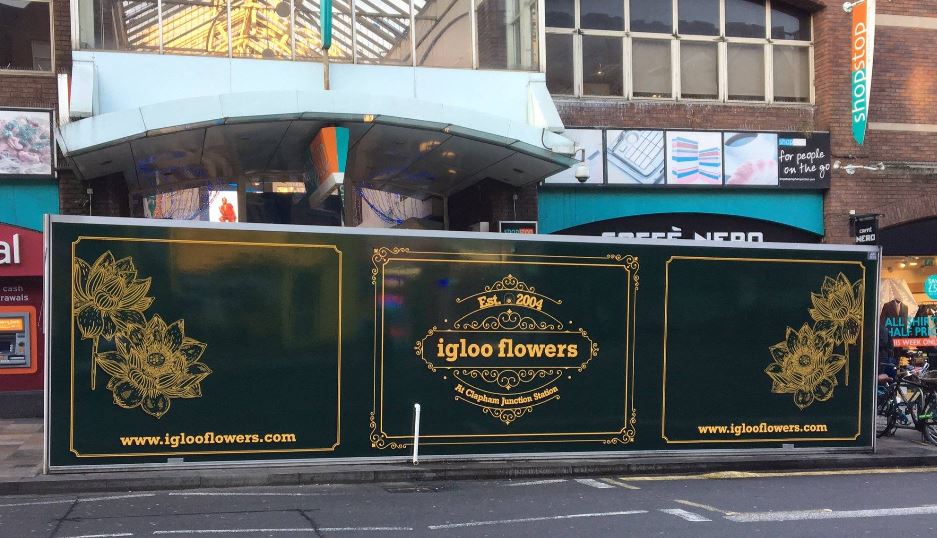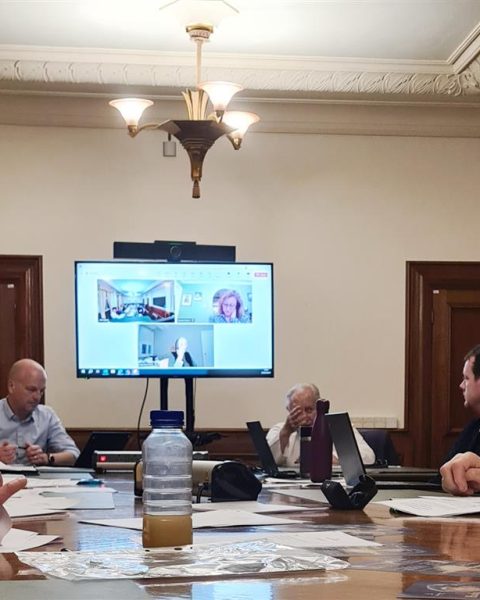The Planning Committee has refused the proposal for a development on the Springfield site seeking permission to build an additional 449 residential units, in addition to the 839 already being constructed. The surprising result occurred as two Labour councillors joined the Conservative members to oppose the plan.
A proposal seeking to circumvent a previous refusal of building 1200 units
Springfield Hospital is a psychiatric hospital in Tooting, South London, and also serves as the headquarters of the South West London and St George’s Mental Health NHS Trust. The site has been subject to applications for almost 15 years, and permission to build 839 residential units was granted on appeal in 2012. This decision was made by a planning inspector after 1,200 units were considered overdevelopment and rejected by Wandsworth Council in 2009 (planning application no. 2008/4452).
The new proposal (planning application 2022/5288) was to redesign the occupation of the already permitted redevelopment (blocks X, Y, Z), on the southern end of the hospital estate. The applicant, Barratt London, argued that this would require higher density, massing, and building heights than were previously envisaged, and therefore the creation of an additional 449 units. Their new scheme would result in a total of 1,288 units for the entire Springfield site.
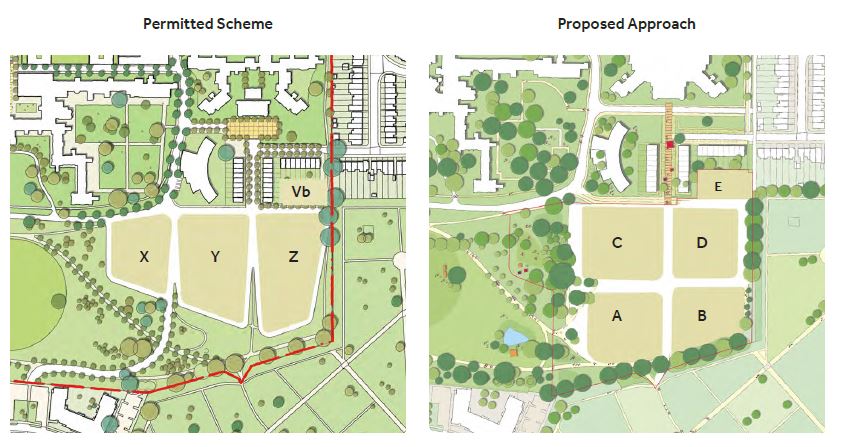
However, many objectors noted that this new total of 1,288 dwellings looks remarkably similar to the original plan of 1,200 units.
Along with reasons related to transport, bulk and location, use of the MOL and the loss of trees, one of the main justifications for refusal stated in 2009 was:
“The development by reason the the siting, height and location would be out of character with the surrounding residential area causing detriment to the amenities of neighbouring occupiers. The development would therefore constitute un overdevelopment of the site […]”
The new application was submitted in January 2022, and many objections were made during that very long period until March 2024. The Wandsworth Society said:
“The current application by Barratts London, with the support of the Hospital Trust, has resurrected the spectre of 1288 homes seemingly in defiance of the Appeal decision which had been welcomed at that time.”
They added:
“This type of intervention to seek increases in the potential of their development sites is not unusual for private developers in our experience, but not on this huge scale, nor following a major public planning appeal and inspector’s report. We were therefore most surprised to learn last July at a meeting with the Hospital Trust, that such a late move was to be made by a public institution without earlier, prior consultation of its strategy to seek a major amendment to its appeal permission.”
- Read our previous article with a presentation of the plan and the many objections raised against the scheme: Springfield Hospital: The applicants are now seeking to build 53% more than permitted on protected land
The debate started with a representation from Conservative councillor Peter Graham who spoke on behalf of his ward constituents who opposed the scheme. He noted that on the Council’s website, there were 9 genuinely supportive comments, and 529 objections received against this application. He highlighted that previously the Council had refused to allow Springfield to be overdeveloped and the 839 units that were eventually granted in appeal for the site had already been reached. He said:
“Now, Barratts wants more units than the planning inspectorate rejected. […] It’s developer’s greed with a NHS sticker slapped on top. […] NHS capital funding is no excuse for overdevelopment. The Trust was already getting out of Springsfield more than it could reasonably expect”
While he cited the community groups which objected, he also mentioned the fact that the Mayor of London (and the Greater London Assemble – GLA) initially stated that the application did not comply with the London Plan, and would result in harm and that there must be a reduction in height and mass.
Wandsworth planning department seemed to come to the rescue of the developers as they responded that “since the consultation, officers had been able to demonstrate that the scheme was compliant“. However, the compliance appeared to be referring to the issue related to building on MOL, without addressing the other criticisms made by the GLA in terms of height and mass, with some blocks labelled as “a symptom of overdevelopment”.
Allowing social housing to deteriorate in order to discount their existence
Another strategy, often employed by developers, was also highlighted when the committee discussed the level of affordable housing. Within the 449 units proposed, the applicants were proposing a total of 220 affordable housing units, divided equally between Social Rent and Intermediate (calculated by habitable rooms, resulting in 95 social units and 125 shared ownership units).
However, committee members highlighted the loss of existing affordable housing in some of the existing blocks (such as the Diamond estate). This two-storey building on the site (along with the Morrison Building and the Shaftesbury Building, which will also be demolished) currently provides 37 residential units for nursing staff. Therefore, it was argued that not only were the 125 shared ownership units not truly affordable (with half of them being available for a family with an income of up to £90,000), but also that, in reality, the level of new affordable (and in this case, social) housing was much lower when taking into account the loss of the nursing units.
Cllr White pointed out that the initial plan of 1200 units was reduced to 839, but the new scheme was now presenting an even larger number of housing, and therefore the global figure needed to be taken into account when considering the level of affordability. In that case, the percentage was only 29%, which “is really not that good for such a big site,” he said.
Nick Calder, the Head of Development Management, responded that the units were poorly maintained and had been decanted over the years. Therefore, technically, they were no longer existing, which is the reason why they were not included in any calculations. He added, “[we] spent about 12 months negotiating on affordable housing to see whether we could move the figures. There was an initial change up to 50% affordable because before it was not policy-compliant, and they moved from 60/40 with the majority intermediate to 50/50 with an equal amount of social housing. [An additional] 22 affordable units could be provided, which would increase the amount to 32%. […] I do not recall seeing that for many many years.”
However, a similar strategy is sometimes put forward by developers to minimize their obligations. This was employed by Peabody when they submitted their scheme in 2012. In 2010, Claire Bennie, Deputy Head of Development at Peabody Trust, acknowledged that they decided in past years to lease some of the flats on a short-term basis, so they could be emptied and used to relocate tenants during the different phases of the project. From the original 353 social units, 75 of them where removed from their provision of social housing and put on the private market; it later became 132 and only 221 units where kept as social housing, which led Peabody to claim that they were replacing all of them in their new scheme, while they were, in fact, reducing the share of social housing by 40%.
Is building on protected Open Land acceptable?
While the proposed development would be constructed on protected Metropolitan Open Land (MOL), which is afforded the same status and level of protection as the Green Belt by Policy G3 of the London Plan, the applicants argue that the funding arrangement for the new hospital justifies outweighing the substantial harm caused by the development.
The applicant’s initial statement acknowledged that “the proposal would be regarded as inappropriate development and would not meet any of the exceptions [to gain authorization].” However, they later found a way to circumvent those considerations by asserting that “the whole of the site should be considered as previously developed land” (PDL) due to some areas of MOL within the site having previously received authorization for development.
This designation is critical as in one situation (MOL), the encroachment is nearly impossible, while in the case of a precedent (PDL), the justification is much easier: building is not ‘inappropriate’ and a ‘very special circumstances’ case does not need to be made. This position was supported by Wandsworth officers who stated that “in listing the site on the Brownfield Register, the Council has accepted that it is PDL.”
With the obstacle of the strict conditions to allow development on MOL having been skirted, and the applicant’s provision of 50% affordable accommodation in the new proposal, the officers seemed at ease to provide an unusual “on-balance” justification (par. 2.56 of the report):
“The development would not cause substantial harm to the openness of the MOL and would contribute towards meeting an identified housing need within the borough.”
Wandsworth officers appeared very uncomfortable to support the refusal of the committee members
Tony Belton, the Chair of the Planning Committee, allowed the full discussion to extend to more than 2 hours until the exhaustion of questions and comments, both in support and against the proposal.
“It was a fascinating debate“, commented an observer, “and I don’t think the Chair expected the outcome“.
While Cllr. Belton was clearly in support of the scheme (stating that, in his view, it provided a considerable amount of affordable housing and that the transport issue — classified as very poor for this area — was ‘manageable’), he did not prevent anyone from expressing other opinions and even intervened at some points to facilitate resolution. “I assure you, I am trying to be as diplomatic as possible,” he said.
And indeed, stating that the final discussion was not straightforward is an understatement. It took another 30 minutes to vote on the final motion, resulting in the scheme being refused, with officers expressing doubts about the credibility of the reasons given by committee members to refuse the applications. Nick Calder said: “I don’t think the [reason to refuse due to] the encroachment on Metropolitan Open Land is right.” And at numerous times during the final discussions, Duncan Moors, Wandsworth Legal adviser, expressed his discomfort:
“I think the tests are clearly set out within [the report, and the officer concluded that] the development would not cause substantial harm to the openness of the [MOL] and would contribute towards meeting an identified housing need. […] We need to identify some harm […] I am struggling to understand what that harm […] would cause. “
“Now, with respect Mr Moors, I think you may not like it but the amendment is as it is.”
Eventually, Conservative councillor Ravi Govindia (seconded by cllr Humphries) phrased the reason for refusal being:
“That planning permission be refused on the grounds that the development would cause substantial harm to the openness of the Metropolitan Open Land and that there would be unreasonable pressure on public transport and surrounding road networks, which would have implications for both existing residents and proposed residents under this scheme.”
An encouragement for developers to play a cynical game
The application to extend the redevelopment of Springfield Hospital was refused, but there might be further episodes. The applicants might decide to appeal, or the decision could be called in by the GLA.
The 2012 plan was refused for reasons of overdevelopment, encroachment on open land, and transport issues. Twelve years later, while the initial considerations for refusal still prevail, the developers decided to give another go with their initial scheme, this time arguing that the land was not ‘so protected’ and that the transport issue was ‘manageable’.
While the application was seen by many as a clear attempt to circumvent the appeal decision that refused the initial scheme of 1200 units in 2012 and reduced it to 839, it could be viewed as an encouragement for applicants to pursue their usual game: the strategy of smaller steps to eventually try to bend the will of the Council to approve something that they would have initially refused.
In the past, developers have employed this strategy of ‘small steps’ on many occasions, and local residents might remember plans for St Peter’s site on Plough Road, Parma Crescent site, Peabody estate in St John’s Hill or former B&Q site in Wandsworth Roundabout. The goal is always similar: an attempt to bend the will of the Council to approve something that would have been otherwise refused.
In the specific case of Plough Road, Tony Belton (then seating in the opposition at the Planning Committee) raised a motion to refuse and explained:
“We’ve already given permission 6 months ago with many of us doubtful, and it covered the point of providing more accommodations. You cannot just add as much as you like. There is a very good ground to refuse this application on the basis of over-development, over-density, un-neighbourly”
Conservative councillor Paul Ellis made a similar comment: “It’s amazing when developers got approval and come back with something a little bit different, a little bit bigger. It’s unusual to have anything smaller“.
We could conclude this article with the final words of Cllr. Graham, who spoke at the start of the discussion. His statement could have been used for so many schemes that were approved during the Conservatives years in Wandsworth. However, it will also be certainly useful for many forthcoming proposals, including the Glassmill site at 1 Battersea Bridge Road and the Gas Works site. Cllr Graham said:
“You now have a choice: You can uphold past decisions and maintain the integrity of [Wandsworth] planning system, or you can let developers get away with cynically pushing schemes to the limit and then coming back for more.”
In the following video, we compiled key points of the debate.
Update: Article updated to add information related to the comments made by the GLA.
Update 10/05/2024: We have received the following comment from Alastair Butcher, Development Director at Barratt London:
“We are disappointed that our latest planning application at Springfield Hospital has been refused by Wandsworth Council’s Planning Committee after being recommended for approval by the planning officers. This decision comes a week after the Mayor of London announced an ambition to build 40,000 new homes. LB Wandsworth continues to be hit hard by the ongoing housing crisis and there is an urgent need for housing both within Wandsworth and across London.
“Our plans propose 449 new homes as part of the new Springfield Village development which includes 32 acres of public parkland, cafes, retail space, mental health facilities and a public square. Almost 50% of the new homes (220 flats) will be affordable, comprising a mix of 50% social rent and 50% shared ownership.
“Not only does this refusal mean a further deficit in local housing supply, but it fundamentally stalls substantial financial contributions to local infrastructure projects, including £49m to much-needed hospital buildings in Tolworth. This NHS redevelopment would provide significant mental health facilities serving 1.2m people across Wandsworth and four other South West London boroughs.
“The development would also support the creation of over 500 jobs in South West London; and a contribution of approximately £10 million to support and improve local services including education, arts, culture and transport.
“Wandsworth Council’s Planning Committee apparently rejected our plans on the basis of the impact on the previously developed Metropolitan Open Land, and pressure on the surrounding transport network. These reasons are, in our view, unsubstantiated and the Council’s professional planning officers supported our proposals following a two-year application period.
“This refusal has unnecessarily delayed private and affordable housing; and infrastructure delivery, rendering the wider Springfield Park development incomplete for the foreseeable future, and most importantly, will have a severe impact on mental health provision within South West London. We are working closely with STEP and the NHS Trust to consider our options, including appealing this decision.”


